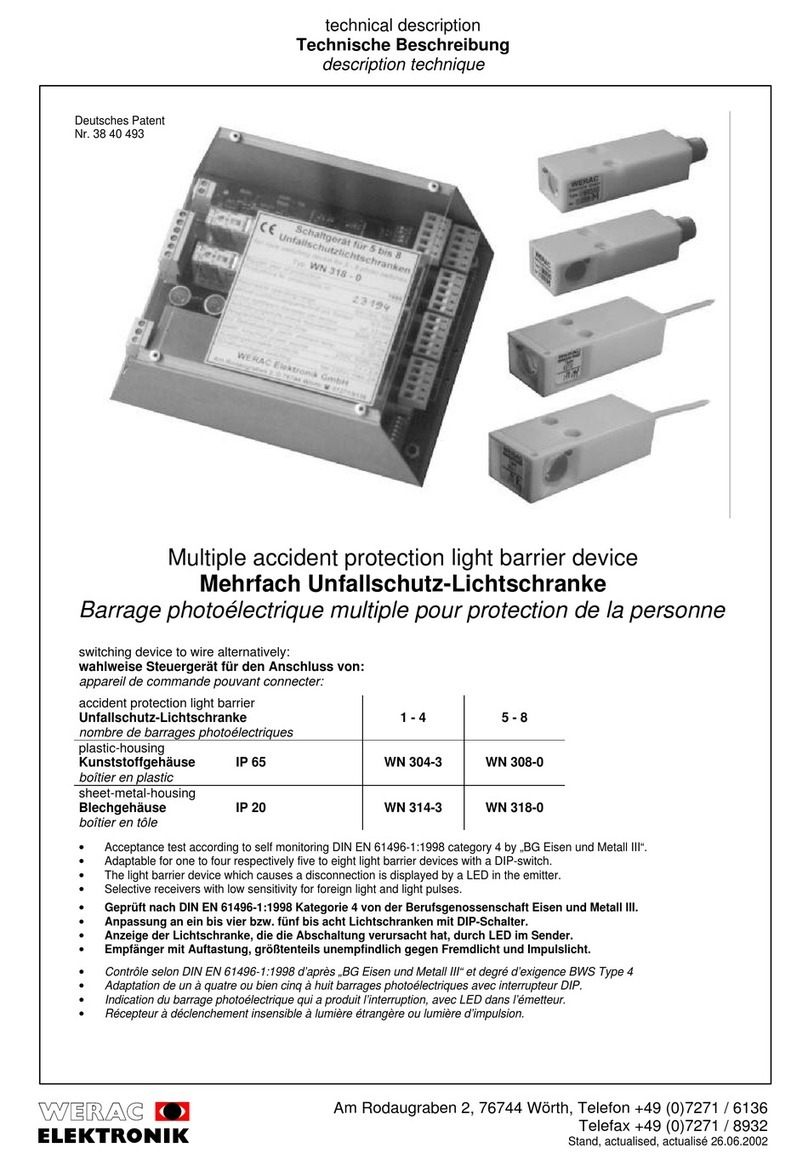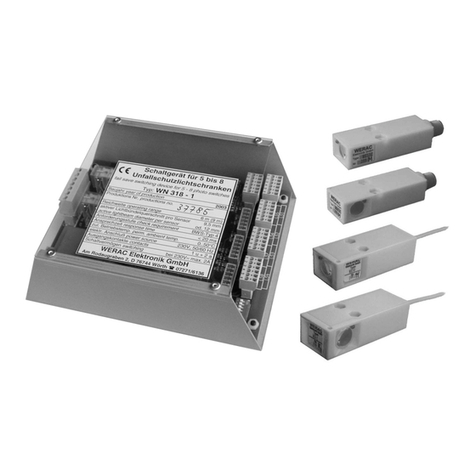
Version 10.12.2019
page 4 WERAC Elektronik GmbH
3 Technical Data for the WGN 100-1 control unit
Standard to IEC EN 61496-1 Type 4
Performance Level PL e, Category 4 (EN ISO 13849-1, 2008)
PFH / TM 4,93 x 10-8 1/h / 20 years
Response time see section 6.5
Permissible operating temperature 0... +50°C / 32... +122°F
Stock temperature -25°C... +70°C / -18°F... +158°F
Supply voltage WGN 100-2 24 V AC ± 10% 48 – 62 Hz, 24 V DC ± 10%
Power consumption WGN 100-2 approx. 8 VA
Supply voltage WGN 110-0 24 V AC ± 10% 48 – 62 Hz, 24 V DC ± 10%
Power consumption WGN 110-0 approx. 12 VA
Output contacts:
max. switching voltage
max. switching current at 230 V~ (ind. load)
max. switching frequency
min. operating cycles
250 V~
2 A
2 /s
106 with contactor for 5.5 kW 3-phase motor
Switch-on delay after power supply ON ~ 4 s
Switch-on delay after test ON ≤ 70 ms
Housing Sheet-metal housing with Makrolon cover
Enclosure rating IP 20
Electrical connection Terminal plug, up to 2.5 mm²
RJ 45 connector (emitter and receiver)
Status display red, yellow, green
Start enable T1, T2 External voltage 10-50 V
Table 1
External connections control unit WGN 100 (see fig. 1)
connection A1-A2 (normally open contact) security output relay A - OSSD 1
connection A5-A6 (normally open contact) security output relay B - OSSD 2
connection A3-A4 (normally closed contact) e.g., message to PLC, rest contact query,
display red
connection A4-A7 (normally open contact) e.g., message to PLC, display green
connection T1, T2 start release of the sequential switching
connection 24V, 0V electricity supply with 24 V
Table 2
Additional external connections control unit WGN 110 (see fig. 2)
connection B1, B2 contact monitoring circuit 1
connection B3, B4 contact monitoring circuit 2
saftey category 4
contact pair 1
connection B5, B6 contact monitoring circuit 1
connection B7, B8 contact monitoring circuit 1
saftey category 4
contact pair 2
Table 3
The relay outputs are line voltage isolated from the light barriers; to IEC60664 -1 overvoltage
category III.
All emitters WGS4... and WLS4... and all receivers WGE4... and WLE4... can be connected.
The control unit is built only for the use inside of control cabinets. The Sheet-metal housing
can be snapped on to the TS 35 for mounting inside control cabinets. The control cabinet must
comply with degree of pollution 2 to IEC EN 60439-1 at least (This is normally IP 54). The
mounting rail TS 35 must be connected to the PE conductor.





























